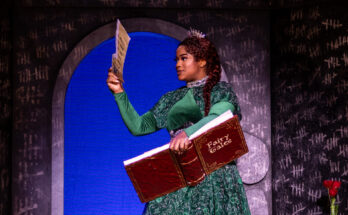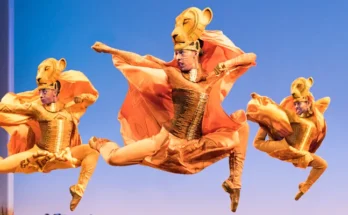Atlanta Ballet has been dancing The Nutcracker for 51 years, longer than many of us in its audience have been alive. Think about that for a moment — and try to grasp just how steady, inspired and determined that makes this company of artistic athletes and its leaders.
It’s appropriate then that this season’s Nutcracker nods to Atlanta Ballet’s traditions, celebrates its present and looks with giddy anticipation to its future.
This is a watershed moment for the nation’s longest continuously operating dance troupe, born in 1929 and emboldened in 2010. It has a new executive director, a gorgeous new home, a season alive with world and company premieres, and an excitement that is contagious. Even its annual holiday gift to metro Atlanta features a few new wrinkles:
- The Atlanta Ballet Orchestra will play live at each of The Nutcracker’s 23 performances. Not so long ago, a cash-challenged Atlanta Ballet was forced to use recorded music.
- Dozens of new costumes conceived by designer April McCoy will decorate the long limbs and graceful ways of the Nutcracker’s 200-plus performers. The core company of 21 dancers and six apprentices was still perfecting its Moulin Rouge can-cans when stitchers in the costume shop began wrestling with the beads and other detailed flourishes required for Sugar Plum Fairies and a heroic Prince.
- Brother and sister Jared and Abigail Tan from the Philippines will dance their first Nutcracker as company members, joining colleagues who come from such disparate places as Minnesota, Connecticut, California, Canada, South Korea, Uruguay, and of course, Georgia.
To create this annual winter wonderland, it takes 20 pounds of snow; eight tons of scenery, lighting and props; and a 38-ft. tall Christmas tree. This Nutcracker, choreographed by Atlanta Ballet Artistic Director John McFall, met its first Atlanta audience in 1996. It’s set in St. Petersburg, Russia, and features the fanciful journey of a little girl named Clara, who meets some extraordinary characters as her dreamy fantasies melt into reality.
Before 1996, Atlanta Ballet danced the great George Balanchine’s Nutcracker, which is set in Germany and features a young heroine named Marie. Atlanta Ballet was the first company outside of the New York City Ballet given permission to dance the storied Balanchine version.
That’s just one of many stories in the company’s history book, one that adds a fat and happy new chapter with the 2010-11 season. The Nutcracker dancers prepped this year’s ballet in their brand-new home on the far west edge of West Midtown. The $10.9 million, 54,000-sq. ft. facility is spacious, airy, bright and energy efficient — it’s the only arts headquarters in the country with Gold LEED certification.
If you’d ever stepped foot in the ballet’s well-worn former headquarters on West Peachtree Street, you’d realize just how far it has come. Costumes can now be seen where they are stored. Sets and props (formerly crafted at a separate location) can be wheeled from a next-door warehouse into rehearsal studios. Little dancers coming to class aren’t stacked knees to elbows in a lobby that serves as entrance, exit, office space and waiting room.
The Michael C. Carlos Dance Centre, as the new space is called, features five studios, a physical therapy suite, a student library, costume shop, dressing and locker rooms for both the professional company and students, and a boutique. Yet to come: a black-box theater at which previews and special events will be staged.
The Centre’s main hallway is adorned with large blown-up, black and white photos of company members such as Christine Winkler, who’s now in her 16th season and has danced most of the company’s leading roles. Another signature is a translucent material called “Kalwall” that forms the building’s outer walls. These energy efficient panels play nicely with both natural and artificial light and give the new Centre its architectural accent.
The beauty and functionality of the Centre can’t be underestimated, especially if you’re an Atlanta Ballet dancer. This is where, for all intents and purposes, the dancers live 10 or so months each year.
Atlanta Ballet looks to its future with longtime leader McFall, also in his 16th season, and Executive Director Arthur Jacobus, who spent 20 years with the Pacific Northwest and San Francisco ballets, and came to Atlanta after seven years as CEO and executive director of the Pilchuck Glass School in Seattle.
“After a nearly seven-year absence, it is exciting to have the opportunity to once again serve the art form about which I am most passionate and in which I have the most experience,” Jacobus says.
McFall is jazzed about a $500,000 fund that Jacobus created so the company can seek out talented new choreographers in both the United States and abroad. His dancers, McFall says, are thrilled and “vitally interested in working with the best choreographers around the globe.”
Perhaps ballet leaders didn’t realize how prescient their purchase of the West Midtown property would prove to be. The former home of a Hotpoint appliance factory, the location is on pointe and hotter than ever, in ways its previous tenants could never have imagined.
Kathy Janich is an Atlanta theater artist and freelance writer. After years in daily newspapers, she’s found a joyous second career as an artistic associate at Atlanta’s Synchronicity Theatre. Visit synchrotheatre.com.



